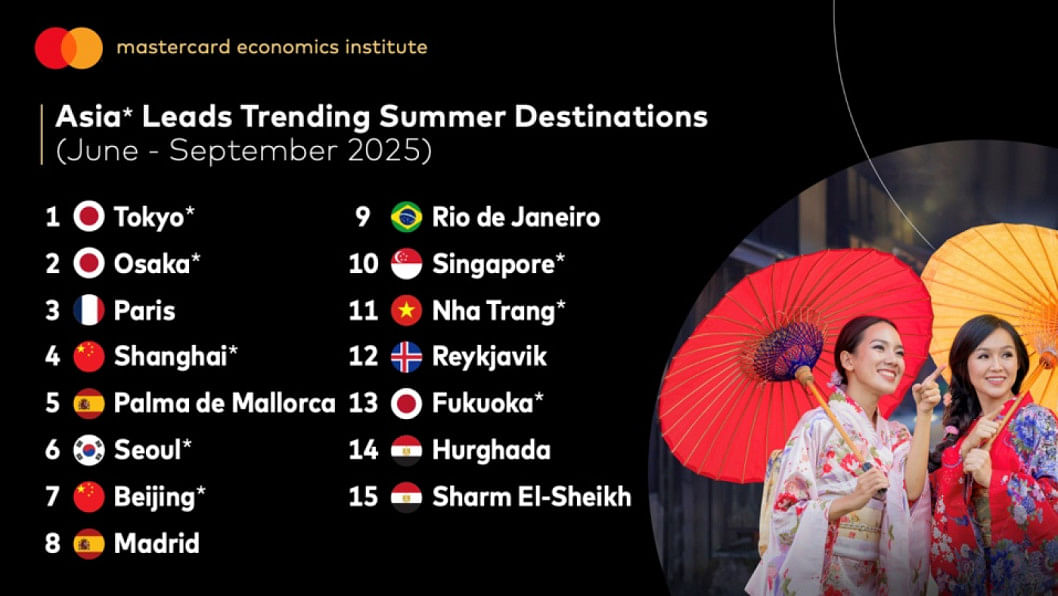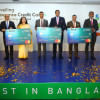Tokyo, Osaka top trending destinations for summer travel

Tokyo and Osaka are the world's number 1 and 2 top trending destinations for summer travel (June–September 2025), according to the annual Mastercard Economics Institute (MEI) report on consumer spending in the travel economy.
In 2024, Japan's capital city climbed from the number two spot it held in 2023 to lead global travel demand heading into the peak summer season.
Meanwhile, Nha Trang in Vietnam made a surprise entry into the list, climbing in popularity thanks to its beautiful beaches, enviable coastline, and vibrant nightlife, said the report, Travel Trends 2025.
The Chinese Mainland retained its position as the world's largest outbound travel market in 2024.
Chinese travellers are increasingly prioritising value and visa-friendly destinations, including Japan, Malaysia, and Singapore.
Interest in Central Asian destinations such as Kazakhstan, Uzbekistan, and Kyrgyzstan is also increasing.
Meanwhile, Dhaka has become the 13th fastest-growing city for Indian travellers, with a 31.2 percent increase in visitors in 2024 compared to 2019.
Moreover, the capital of Bangladesh is also becoming a popular destination for Malaysian travellers, according to the report.
Asia-Pacific is home to eight of the world's top 15 trending summer travel destinations, said the report that uncovers what is shaping travel choices today.
Travel Trends 2025 draws on a unique analysis of aggregated and anonymised transaction data and third-party data sources, Mastercard said in a statement today.
"The Asia-Pacific region continues to set the pace for global travel, with buzzing destinations like Tokyo, Shanghai, Seoul, and Singapore capturing the imagination of travellers around the world," said David Mann, chief economist for Asia Pacific at Mastercard.
"Even as economic uncertainty persists, travel remains a bright spot—driven by people seeking meaningful, value-driven experiences," he said.
"From exchange rates to regional accessibility, travellers are making smarter, more intentional choices about where they go and why, with a clear shift toward more personal, purposeful journeys."
"This report is designed to offer a clearer view of how consumer behaviours are evolving—and what that means for tourism growth," added Mann.
"By turning data into actionable insights, the Mastercard Economics Institute aims to support the travel ecosystem in making smarter decisions that drive stronger tourism strategies, better traveller experiences, and more resilient economic outcomes."
India again posted the country's highest number of outbound travellers on record in 2024.
Indian tourists are exploring a broad mix of destinations—the top three being Abu Dhabi, Hanoi, and Bali—with growth supported by expanded direct flight connections and a rapidly growing middle class eager to travel.
Together, the two markets continue to play an outsized role in shaping global travel flows, according to the report.
Across Asia-Pacific, travellers are prioritising dining, nature, and wellness as key motivators for travel, seeking meaningful moments over traditional sightseeing.
Destinations like Gianyar in Bali, Indonesia—known for its iconic Babi Guling spit-roasted pork—and Queenstown in New Zealand, where restaurants welcomed tourists from 44 countries in 2024, are standing out as globalised culinary hotspots.
According to MEI's Wellness Trend Index (WTI), Thailand is among the destinations leading the way in relaxation experiences and self-care.
At the same time, the rising WTI score for New Zealand suggests a growing effort to be part of this popular movement.
The Mastercard report also mentioned that the rise of sports tourism is continuing, with major events like the Australian Open tennis tournament and the Baseball World Series in Los Angeles drawing significant international spending.
Shohei Ohtani's World Series debut saw spending by Japanese visitors surge by 91 percent—six times the broader cross-border boost—highlighting how sporting events are proving to be powerful travel catalysts for fans.
Travellers from Asia-Pacific tend to be more sensitive to exchange rate shifts.
Turning to the US, MEI's analysis shows that tourists from India, Singapore, South Korea, and Taiwan are particularly sensitive to exchange rate fluctuations, after accounting for other factors.
Specifically, a 1 percent depreciation of the US dollar against their local currencies corresponds to an approximate 0.6–0.8 percent increase in the number of tourists travelling to the US.
These findings, consistent with MEI's earlier analysis of tourism to Japan, suggest that these travellers are more responsive to exchange rate movements when selecting outbound destinations.
Corporates today are limiting global travel in favour of regional trips, and while people are taking fewer business trips overall, the average duration is longer—suggesting efforts to stretch travel budgets.
For example, US-based travellers' trips to Asia-Pacific increased from 8.8 days to 10.2 days, according to the report.
According to MEI, fraud in popular tourist destinations spikes by up to 28 percent during peak seasons.
Common scams include inflated charges in restaurants and taxis, fake tour companies, and fraudulent property listings.
To combat these, Mastercard employs advanced fraud prevention technologies, including digital wallets and AI-driven systems, to protect travellers and ensure they can focus on their journeys without worrying about security threats.

 For all latest news, follow The Daily Star's Google News channel.
For all latest news, follow The Daily Star's Google News channel. 








Comments